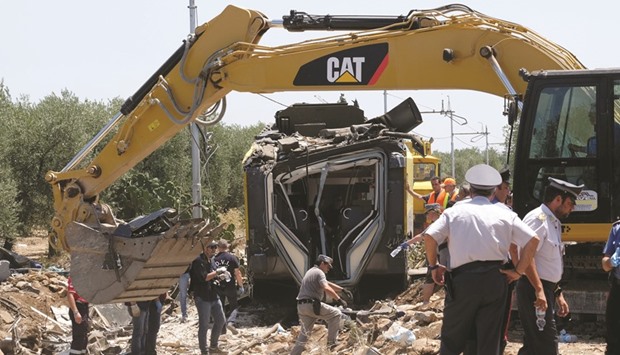A deadly train collision in Italy could have been caused by a “risky” signalling system in place on the line, Italy’s minister of transport said yesterday, as sobbing relatives identified victims of the crash which claimed at least 25 lives.
The system on the single-track line by which station managers communicate directly with train drivers was “one of the least sophisticated and most risky”, Graziano Delrio told parliament a day after one of the country’s worst rail accidents.
“Unfortunately, a system like this means the controls lie with humans,” leaving a window for human error, he said.
Victims’ families attended the Policlinico hospital morgue in Bari to identify their loved ones after Tuesday’s high-speed head-on collision between two busy passenger trains in the Puglia region of southern Italy.
Cries rang out of “let us have our dead!” as frustration rose over a restriction on the numbers allowed into the morgue, with many left sobbing outside in the scorching heat.
Red Cross workers had earlier asked for distinguishing features and other details to help identify the most badly injured, from tattoos to scars and clothing.
One man described the necklace his sister-in-law had been wearing, another the engagement ring on his fiance’s finger.
Vitangelo Dattoli, the hospital’s director general, told AFP that 22 of the 23 bodies recovered from the wreckage had now been identified, and would be released tomorrow in time for funerals from Saturday.
He said 24 out of 52 people injured were still in hospital. The death toll had earlier been put at 25 but was later revised down.
Officials said they had recovered the black boxes from both trains following the collision which happened in open countryside and left some carriages in bordering olive groves.
One of the four-carriage trains was supposed to have waited at a station to let the other train through, before heading down the track between the towns of Corato and Andria.
The trains were operated by private railway company Ferrotramviaria — just one of the 30 or so private companies which run on small lines criss-crossing Italy in areas not covered by national operator Trenitalia.
About 55% of the rail network in Italy is single track.
A pot of 150mn euros allocated by the European Regional Development Fund in the 2007-2013 budget to add second tracks went largely unused, La Stampa daily said.
Delrio said the government was immediately pouring 1.8bn euros in investment into the regional networks.
He also said the national rail network needed to be unified, as the government currently does not manage regional lines, which he said should be brought up to speed with the latest technologies.
Prime Minister Matteo Renzi visited the site late Tuesday, saying it was “a time to cry, be close to the families, show humanity in our pain”, and vowing to “throw light on what happened and who is responsible”.
University students, farm workers and office employees were on the trains, as well as grandparents and children.
The bodies of a mother and child were pulled from the wreckage, while a trapped six-year-old boy was found trapped, alive, next to his dead grandmother.
He was given cartoons to watch on a smartphone to calm him down as firefighters cut him out.
One of the victims was a farmer who had been working in a field next to the crash and was struck on the head by debris.
Hospitals tending to the wounded had to turn blood donors away after a show of solidarity from thousands of Italians.
Ferrotramviaria said it was not possible to say how many people had been on board, as many passengers had season tickets.
The last major rail disaster in Italy was in 2009, when a freight train carrying liquid petroleum gas derailed and exploded, killing 29 people at the station in the town of Viareggio.

Officials inspect the train crash site near Corato, in the southern Italian region of Puglia as rescuers searched for missing bodies from the wreckage of a head-on collision on Tuesday that claimed at least 25 lives.


